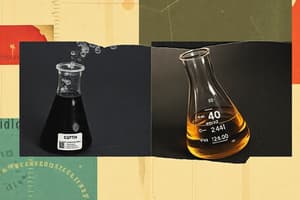Podcast
Questions and Answers
What symbol is used to represent irreversible reactions?
What symbol is used to represent irreversible reactions?
- → (correct)
- +
- ⇌
- ∆G‡
What is the meaning of 'reaction equilibrium'?
What is the meaning of 'reaction equilibrium'?
- When the rate of the forward reaction is zero
- When there is no activation energy
- When the rate of the forward reaction equals the rate of the reverse reaction (correct)
- When the energy levels of the ground state and transition state are equal
What does a bidirectional arrow (⇌) represent in a chemical reaction?
What does a bidirectional arrow (⇌) represent in a chemical reaction?
- Activation energy
- Reversible reaction (correct)
- Transition state
- Irreversible reaction
What is the purpose of enzymes in biological systems?
What is the purpose of enzymes in biological systems?
What is the role of activation energy (∆G‡) in a chemical reaction?
What is the role of activation energy (∆G‡) in a chemical reaction?
How can reaction rates be effectively increased?
How can reaction rates be effectively increased?
What is a reaction intermediate?
What is a reaction intermediate?
In an enzyme-catalyzed reaction, which complexes can be considered intermediates?
In an enzyme-catalyzed reaction, which complexes can be considered intermediates?
What determines the overall rate of a reaction with several steps?
What determines the overall rate of a reaction with several steps?
What is the highest-energy point in the reaction coordinate diagram called?
What is the highest-energy point in the reaction coordinate diagram called?
In enzyme-catalyzed reactions, what are less stable chemical intermediates called?
In enzyme-catalyzed reactions, what are less stable chemical intermediates called?
What term is used for the step(s) that have similar activation energies in a reaction?
What term is used for the step(s) that have similar activation energies in a reaction?
What is the main difference between allosteric and non-allosteric enzymes?
What is the main difference between allosteric and non-allosteric enzymes?
Which type of reaction proceeds in both directions, allowing reactants to reform the products as well?
Which type of reaction proceeds in both directions, allowing reactants to reform the products as well?
What is the role of a catalyst in a chemical reaction?
What is the role of a catalyst in a chemical reaction?
How are irreversible reactions represented?
How are irreversible reactions represented?
Which type of enzyme has transient complexes involving the enzyme, substrate, and product?
Which type of enzyme has transient complexes involving the enzyme, substrate, and product?
What aspect of a chemical reaction is influenced by enzymes?
What aspect of a chemical reaction is influenced by enzymes?
Flashcards are hidden until you start studying




